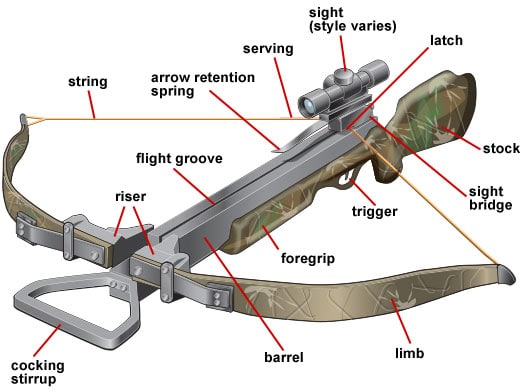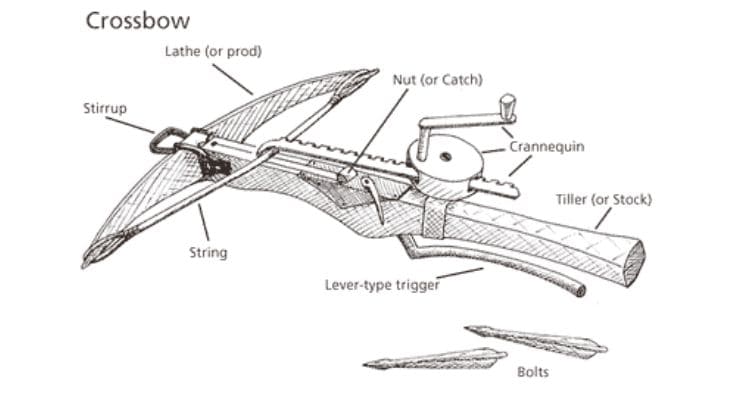How Crossbow Works? Understanding the Mechanics of a Crossbow
The crossbow is an ancient ranged weapon that is used for hunting and target shooting. The weapon was also used as a military weapon during wars. The basic crossbow consists of an elastic, fast-moving string for launching the projectiles. Most hunters prefer this weapon due to its high power and speed.
In this article, we will discuss the different parts of a crossbow, how its trigger works, and gain an understanding of compound crossbows. Learning about how a crossbow is made, its design, and how it works can help you become a better hunter or shooter. Let’s begin!
How Crossbow Works: Ultimate Guide
The Anatomy of a Crossbow

A crossbow has several vital components that produce remarkable accuracy and power. These components include the stock, limb assembly, string, cable, trigger mechanism, and bolt.
Stock
The stock is the primary body of the crossbow, which holds all its other components. It is often constructed of lightweight and long-lasting materials such as carbon fiber, aluminum, or polymer.
The stock is intended to give the shooter a sturdy and secure platform, and it often includes a pistol grip, adjustable stock, and foregrip for added comfort and stability.
Limb Assembly
The limb assembly is a crossbow component that retains the energy generated when the crossbow is fired. The limb assembly is made up of two limbs that are attached to the stock and the string.
The limbs are often composed of high-strength materials like carbon fiber or fiberglass and are designed to resist the enormous force imposed on them when the crossbow is released.
String and Cable
The string and cable are two essential crossbow components that function in tandem to launch the bolt. When the shooter cocks the crossbow, the string is joined to the limb assembly and is drawn back. The cable is attached to the other end of the string and assists in maintaining string pressure when the crossbow is fired.
Trigger Mechanism
The trigger mechanism releases the stored energy in the limb assembly when the shooter pulls the trigger. Any errors or failures in the trigger mechanism might result in a misfire or decreased accuracy.
Bolt
The bolt is the projectile fired by the crossbow. Bolts are often composed of high-strength materials like carbon fiber or aluminum and are lightweight and aerodynamic.
For hunting, the bolt tip is usually fitted with a broadhead, whereas it is equipped with a target point for shooting.
Take a Look: We’ve Rounded Up the Best Crossbow Bolts.
How a Crossbow Works

When a crossbow is cocked, the shooter pulls the string back, which stores energy in the limb assembly. The stored energy is released when the trigger is pulled, propelling the bolt forward at high speeds.
Crossbow Care and Safety

Crossbows are useful for hunting and shooting targets. But they need regular care to work well. Let’s look at compound crossbows as an example. You need to take good care of it to make sure it’s fast and accurate.
Taking care of your crossbow is important. You should clean it often and put oil on all its parts, like the string and cable. This stops rust and damage. Also, you have to use it safely. Wear protective glasses, don’t aim them at people, and keep them empty when you’re not using them. These are very important things to do.
How does A Crossbow Trigger work?

While using the crossbow, the most challenging part is to figure out its trigger. As with the passage of time, the designs and the position of the trigger change. But the components of the crossbows should be accurately positioned to have a smooth and fast release each time from the trigger.
When the user cock a crossbow, the prod’s limbs get closer together through the elastic string through which the elastic potential energy is generated. As the string is released, this elastic potential energy is converted into kinetic energy, and the bolt is launched.
The crossbow is technically designed to maximize the stored energy, which is the reason behind the fast propelling of the blot facing the target. Whether you are buying the modern crossbow or using the standard one, both work effectively on the basic principle of converting potential energy into kinetic energy.
The range and the power of the crossbow depend upon how much the amount of energy a gear can hold. The longer the bow draws its length and the higher it draws its weight, the faster it will hit the target. To get a better crossbow experience, the user should increase the bow’s length and weight.
How Crossbow Is Designed

The crossbow’s design is slightly tricky and complicated, with many significant features integrated into it. The basic components of a crossbow consist of a highly elastic string that is drawn back to launch the projectile. The crossbow is a combination of a bow and a rifle.
Let’s talk about the bow part of the crossbow; it consists of a lath or a prod. The position of the lath or a prod is horizontal, which is attached to the tiller. Moving toward the rifle, part of the crossbow includes the stock and a trigger. Before the first rifle, the length of the crossbow originated longer.
As with time, the standard crossbow was transformed into a modern one with a new stirrup device. This stirrup is attached at the front part of the bow, providing bracing when the elastic string is drawn back.
Compound Crossbow

Compound crossbows are more complicated and sophisticated than recurve. It also has a string attached to cables, pullies, and cams for bending limbs.
Therefore, these compound crossbows can apply more tension to the string which is cocked. The compound crossbow is the most popular type of crossbow in America.
How Compound Crossbow Works

The working mechanism of the compound crossbow is fundamental to know as it involves many steps that a user should be considered while using the compound crossbow. Using a simple pulley system, the compound crossbow reduces the weight on the string drawn back.
The most significant feature of the compound crossbow is that it uses the Let-Off technology. The Let-Off technology’s function is to reduce the weight on the drawing back string. To achieve a lower drawing weight which helps the user hold the draw for a more extended period, this compound crossbow uses cam pulleys.
These specially designed cams having an asymmetrical shape, are located at the tip of the limbs. Most of the cams are designed to generate speed, whereas some of them are to provide better comfort. All these parts of the compound crossbow increase the accuracy and speed of the arrow after release. A faster arrow increases the chance of getting an accurate target.
- Benfits: There are two benefits of compound crossbows: faster shooting arrows and ease of aim.
- Downsides: The biggest disadvantage of this compound crossbow is that the whole crossbow is wasted if the string is broken.
Frequently Asked Questions
Conclusion
Hunters prefer this weapon primarily due to its high power intensity and speed. This weapon was also used in the military during wars in the past times.
The most noticeable feature of this weapon is that it works similarly to the rifle having a stock and a trigger. Over time, there has been a drastic change in the crossbow’s design, performance, and construction. While using the crossbow, the most challenging part is to use its trigger part.
Recently, the designs and the position of the trigger in the crossbow have changed, but the components of the crossbows should be accurately positioned to have a smooth and fast release each time from the trigger.
